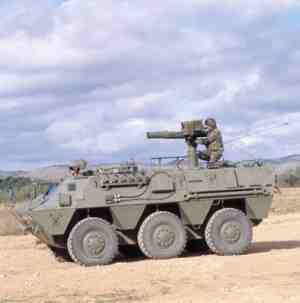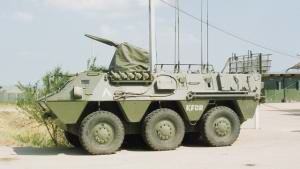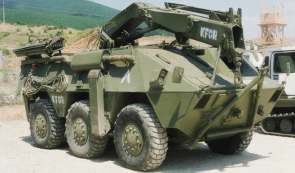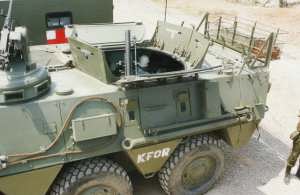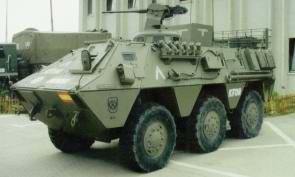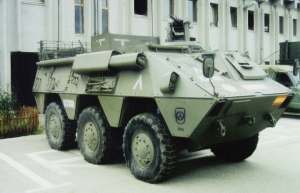| Designation: | BMR-2 / BMR-600 |
 |
|---|---|---|
| Manufacturer: | General Dynamics Santa Barbara Sistemas | |
| Product type: | Armoured Vehicles | |
| Name: | Wheeled armoured personnel carrier |
In 1972, the Comisión de Desarrollo de Vehículos Blindados of the Dirección de Investigación of the Spanish Army Ministry, and the Dirección de Proyectos of ENASA started development work on a wheeled infantry fighting vehicle (IFV) to meet the requirements of the Spanish Army. ENASA was responsible for the automotive side of the vehicle while the army concentrated on the armour and the armament installation. Between 1975 and 1976 the prototype, called the Pegaso 3.500, was tested under a wide range of operational conditions. The engine was behind the driver on the left side of the hull and the armament installation to the right of the engine compartment. Redesigned prototypes had the engine on the right side of the hull and the armament installation to the rear of the driver.
After comparative trials between the BMR-600 (Blindado Medio de Ruedas), the now Renault Trucks Defense VAB and the Swiss MOWAG Piranha vehicles, the BMR-600 was selected for the Spanish Army and the first production order for 15 vehicles was placed in 1979. First production vehicles were handed over to the Spanish Army in 1979.
In 1982, Egypt signed a contract for 250 BMR-600s, the first of which were delivered by late 1984. This order comprised 217 APCs, 13 command post vehicles, 10 recovery and maintenance vehicles and 10 ambulances. These are used by the Egyptian Marines.
In 1983, Saudi Arabia ordered 140 BMR-600s for delivery from 1985. These are used by the marines.
In 1986, Peru purchased a total of 25 BMR-600 vehicles, which comprised 20 APCs, one command post vehicle and four fire support vehicles with a two-man turret armed with a 90 mm gun. These are used by the marines.
Although the BMR-600 family of vehicles was originally designed and built by ENASA, production and marketing of all of the ENASA wheeled armoured vehicles is now carried out by General Dynamics Santa Bárbara Sistemas. Production of the BMR-600 was undertaken at Seville. This is the main General Dynamics Santa Bárbara Sistemas system integration facility in Spain.
Total production of the BMR-600 series of vehicles amounted to about 1,400 of which about 1,000 were for the Spanish Army and the remaining 400+ for the export market.
Although production was completed some years ago, production could restart if further significant orders were placed.
An upgrade programme for Spanish Army BMR-600 and VEC vehicles is now under way by General Dynamics Santa Bárbara Sistemas and additional details are given later in this section.
It is expected that the BMR-600 (6 × 6) vehicles used by Spain will be replaced by a new 8 × 8 vehicle in about 2011 to 2013. Description
The hull of the BMR-600 is made of all-welded aluminium armour and incorporates spaced armour at the front.
Over the frontal arc of 60° (30° left and 30° right), protection is provided against small arms fire up 12.7 mm calibre.
Through a full 360° protection is provided against 7.62 mm small arms fire and shell splinters up to 155 mm in calibre. The underneath of the hull provides protection against anti-personnel mines containing up to 3 kg of high explosive.
The BMR-600 has a crew of two, consisting of the machine gunner/radio operator and driver, and can carry nine fully equipped infantrymen and a commander who dismounts with them. The driver sits at the front of the vehicle on the left side and has a bulletproof windscreen in front of him and a smaller bulletproof windscreen either side (or a periscope). In action, the front windscreen can be covered by an armoured flap and forward vision is then through a periscope mounted in the roof. There is a single-piece hatch cover over the driver's position that lifts and swings to the right. The engine is to the right of the driver with the air inlet and outlet louvres in the roof and the exhaust pipe on the right side of the hull. There is an engine access plate in the front of the hull. The engine compartment has a semi-automatic fire detection and suppression system.
The machine gunner/radio operator sits behind the driver. He has a General Dynamics Santa Bárbara Sistemas TC-3 cupola that can be traversed through a full 360° and is provided with a single-piece hatch cover that opens to the rear and eight day periscopes. A .50 (12.7 mm) M2 HB machine gun is mounted externally.
Over the top of the troop compartment are two rectangular roof hatches that open to the rear. The infantrymen enter and leave the vehicle by a ramp in the rear of the hull that opens downwards. There is also a door in the left rear side in case the ramp fails to open. Depending on the model, six firing ports with vision blocks can be fitted to the sides and rear of the vehicle.
The BMR-600 has an independent suspension system for each wheel station, which is a combination of the hydropneumatic and MacPherson type. This allows each wheel station to be raised or lowered through 275 mm, according to the terrain being crossed. Steering is power-assisted on both the front and rear axles. All three Pegaso designed and built axles are of the double-reduction type with self-locking differentials. The tyres are of the run-flat type.
The BMR-600 is fully amphibious, being propelled in the water by water-jets either side of the hull at the rear, which have deflectors for steering when afloat. When propelled by the two water-jets the BMR-600 has a maximum speed of 10 km/h. The BMR-600 was also marketed without the water-jets and is then powered by its wheels at a speed of 4.5 km/h. Before entering the water a trim vane, which is folded back onto the glacis plate when not in use, is erected at the front of the hull and the bilge pumps are switched on. Spanish Army vehicles are not fitted with the water-jets for amphibious operations.
Mounted at the rear of the BMR-600 is a winch with a capacity of 4,500 kg. Optional equipment includes various radio systems, 14.00 × 20 tyres, run-flat tyres, a 300 litre fuel tank, night vision equipment, an NBC system, communications equipment, a land navigation system, smoke grenade dischargers and an air conditioning system. It can also be delivered without the amphibious capability. Variants
The vehicle has already been fitted with other armament installations, such as the French Nexter Systems (previously Giat Industries) Toucan I turret and the MOWAG 7.62 mm remote-controlled machine gun mounting.
The BMR-600 is suitable for a wide range of other roles including an ambulance carrying four stretcher patients and two attendants; battalion, brigade or division command vehicle; fire support vehicle (for trial purposes it has already been fitted with the French Nexter Systems TS 90 turret armed with a 90 mm gun); section or company command vehicle; radio vehicle; anti-tank vehicle (it has already been successfully tested fitted with the Euromissile HCT turret, with four HOT ATGWs ready to launch); and anti-aircraft vehicle with 20 mm cannon or fire-and-forget surface-to-air missile systems.
The BMR-600 was offered in two mortar carrier configurations, one armed with a turntable-mounted 81 mm mortar, the Model 3560/53E, and the other with a turntable-mounted 120 mm mortar, the Model 3560/59E. Both versions have a total crew of five men, including commander and driver, with the mortar firing through a two-part roof hatch that opens left and right. A baseplate and mount are also carried, allowing the mortar to be deployed away from the vehicle if required by the tactical situation. The 3560/59E 120 mm mortar carrier has four hydraulic stabilisers which are lowered before firing commences to provide a more stable firing platform. The Spanish Army uses both of these versions.
This model is in service with Egypt, Saudi Arabia and Spain. Equipment installed includes a roof-mounted hydraulic crane with a 360° traverse and a lifting capacity of 18,000 kg, four hydraulic stabilisers that are lowered to the ground (two either side of the hull) when the crane is in use, a winch in the hull rear with a capacity of 7,000 kg and 100 m of cable, tools, lighting, welding equipment and a penthouse.
This model is in service with the Egyptian Army (and Spain, which has 16). It has a crew of four (driver, commander and two orderlies) and can carry four stretcher patients or two stretcher and four seated patients.
The Spanish Army has deployed a number of BMR-600 series vehicles with the .50 (12.7 mm) M2 HB machine gun removed and replaced by a new cupola with a single-piece hatch cover that opens to the rear. On the forward part of the cupola is a General Dynamics Santa Bárbara Sistemas 40 mm SB40 LAG automatic grenade launcher.
This model has improved amphibious characteristics and remains at prototype stage.
This is the BMR-600 with the TC-3 cupola removed and fitted with a roof-mounted Euromissile MILAN ATGW launcher, with the missile having a maximum range of 2,000 m. Spain has also fitted some BMR-600 with the Raytheon Systems Company 3,750 m range TOW ATGW system.
This has additional communications equipment, map board and a folding table with personnel maps. To increase the work area a tent can be erected at the rear of the vehicle. This is used by the Spanish Army and has been exported.
This is fitted with a teletype, AM and FM radio equipment and is used by the Spanish Army.
This is used by the Spanish Army under the designation of the BMR-600VZ and is fitted with a winch with a capacity of 10,000 kg and a front-mounted dozer blade.
Early in 1996, following a competition, Scania Hispania (Scania Spain) was awarded a contract by the now General Dynamics Santa Bárbara Sistemas, for the supply of 700 new Scania DS9 diesel engines for installation in the VEC Cavalry Scout Vehicles and BMR-600 armoured personnel carriers of the Spanish Army.
These were delivered over a five-year period starting in late 1996 with the total value of the contract being SKr100 million. The engines have been installed in a total of 642 VEC and BMR-600 series vehicles.
The Scania DS9 is a six-cylinder in-line diesel engine, which develops 310 hp at 2,200 rpm and is more compact and fuel efficient than the original Pegaso engine.
The weight saved by the installation of a lighter engine has enabled additional passive armour to be fitted to the BMR-2 for improved battlefield survivability. This armour could be of the aluminium or ceramic type and spall liners could also be fitted in the troop compartment.
The crew compartment is fitted with a fire detection and suppression system and the layout of the troop compartment will be improved. A new heating and ventilating system is installed.
The maintenance of the vehicle has now been improved, with new indicators in the driver's panel in order to prevent failures before they damage the vehicle.
At present, the BMR-600 is fitted with a TC-3 cupola with an externally mounted 12.7 mm M2 machine gun but in the future, this could be replaced by a TC-13 turret armed with a 25 mm cannon or a light mount for the General Dynamics Santa Bárbara Sistemas 40 mm grenade launcher.
An additional stowage cage has been mounted on the right side of the hull roof with a larger stowage cage mounted on the hull roof at the rear, this extends over the rear of the hull. Additional vertical armour has been provided above the rear troop compartment. This allows some of the infantry when standing to have some level of protection when using their rifles.
When upgraded the BMR-600 is called the BMR-2 by the Spanish Army.
According to General Dynamics Santa Bárbara Sistemas, the upgraded BMR-2 has a total combat weight of 15,400 kg and has a maximum road speed of 95 km/h with the operational range remaining at 1,000 km.
Standard equipment now includes an onboard tool set, 385 litre fuel tank, manual fire extinguisher, pre-installation of communications system, air conditioning system, heating, front-mounted winch with a capacity of 4,500 kg and provided with 45 m of cable, height adjustable steering wheel, pre-installation of NBC system, add-on passive armour protection and bilge pump.
Optional equipment for the BMR-2 now includes a navigation system, automatic fire detection and extinguishing system in the engine compartment, NBC system, night vision equipment for the driver and a global positioning system.
|
||||||||||||||||||||||||||||||||||||||||||||||||
|
||||||||||||||||||
|
|||||||||||||||||||||






